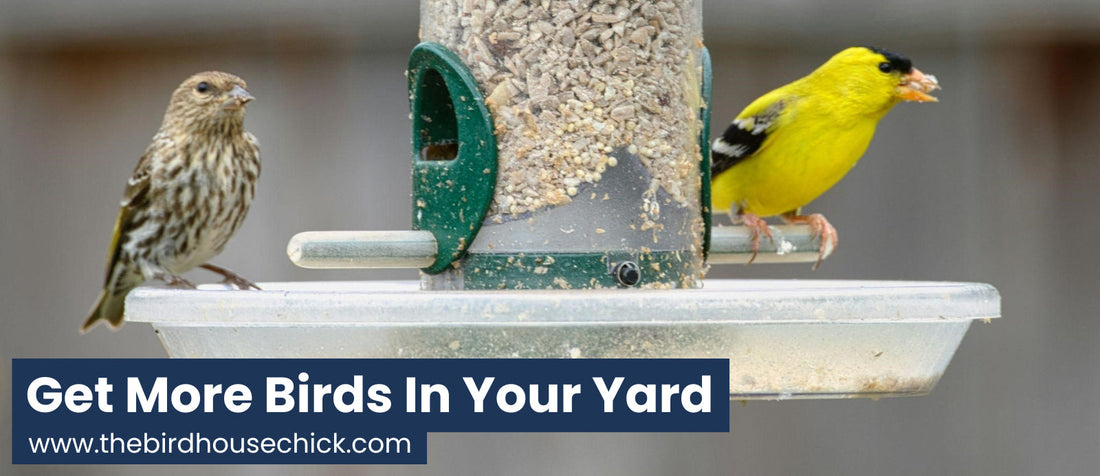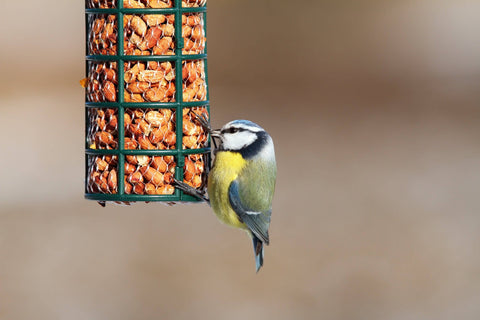Imagine waking up each morning to the cheerful songs of birds right outside your window. Picture the vibrant colors and delightful antics of these feathered friends as they visit your garden.
Sounds wonderful, doesn’t it? If you’ve set up a bird feeder but find it lacking visitors, you’re not alone. Many bird enthusiasts face this challenge, but the solution is simpler than you might think. You’ll discover proven strategies to attract more birds to your feeder.
With a few tweaks and some insider tips, you can transform your backyard into a lively avian haven. Ready to fill your mornings with nature’s melody? Let’s dive into the secrets of making your bird feeder the most popular spot in the neighborhood.

Credit: www.thebirdhousechick.com
Choosing The Right Bird Feeder
Choosing the right bird feeder plays a key role in attracting birds to your yard. The right feeder matches the type of birds you want to invite. It also fits your garden space and weather conditions. A good feeder keeps seeds fresh and safe from pests. Understanding different feeder types, materials, and placement helps you create a welcoming spot for birds.
Types Of Bird Feeders
Bird feeders come in many shapes and sizes. Each type attracts different birds and suits various seeds.
- Tube Feeders:Slim, cylindrical feeders with multiple feeding ports. Great for small songbirds like finches and chickadees.
- Hopper Feeders:Box-shaped and hold lots of seeds. They attract larger birds like cardinals and jays.
- Platform Feeders:Flat trays that hold seeds, fruit, or nuts. They appeal to many birds but also squirrels.
- Niger Seed Feeders:Special feeders with tiny holes for niger seeds. Perfect for attracting finches.
- Suction Cup Feeders:Stick to windows for close bird watching. Best for small birds like sparrows.
Materials And Durability
Material affects a feeder’s lifespan and ease of cleaning. Choose feeders made from strong, weatherproof materials.
- Metal:Durable and pest-resistant. Stainless steel resists rust and lasts long.
- Plastic:Lightweight and affordable. Look for UV-protected plastic to avoid cracking.
- Wood:Natural look blends well with gardens. Needs regular maintenance to prevent rot.
- Glass:Attractive but fragile. Use in safe, sheltered spots.
Placement Tips
Proper placement attracts more birds and keeps them safe.
- Place feeders near trees or shrubs for quick bird cover.
- Keep feeders 10-12 feet away from windows to prevent collisions.
- Mount feeders 5 feet high to avoid predators like cats.
- Choose a spot visible from your window for easy bird watching.
- Keep feeders clean and dry to prevent mold and disease.

Credit: happygardens.com
Selecting Bird-friendly Seeds
Choosing the right seeds is key to attracting birds to your feeder. Different bird species prefer different types of seeds. Offering bird-friendly seeds helps bring a variety of birds to your yard. Quality seeds also keep birds healthy and happy.
Popular Seeds For Attracting Birds
- Black oil sunflower seeds:Loved by many birds, rich in fat and nutrients.
- Nyjer (thistle) seeds:Perfect for finches and small songbirds.
- Safflower seeds:Attract cardinals and grosbeaks, less favored by squirrels.
- Millet:White proso millet appeals to ground-feeding birds like sparrows and doves.
- Cracked corn:Draws larger birds such as jays and pigeons.
Seasonal Seed Choices
Birds’ seed preferences change with the seasons. In winter, high-fat seeds like sunflower help birds stay warm. Spring and summer calls for more protein-rich seeds for nesting birds. Fall requires seeds that prepare birds for migration and colder months.
- Winter: Black oil sunflower, safflower
- Spring/Summer: Nyjer, millet
- Fall: Cracked corn, sunflower
Avoiding Spoiled Food
Fresh seeds attract more birds and prevent disease. Store seeds in a cool, dry place to keep freshness. Clean feeders regularly to stop mold and bacteria buildup. Remove wet or clumped seeds fast to protect bird health.
Creating A Safe Environment
Creating a safe environment is key to attracting birds to your feeder. Birds feel vulnerable and need spaces where they can eat without fear. A secure area invites more birds and keeps them coming back. Safety influences their choice more than food alone.
Protection From Predators
Birds avoid feeders where predators lurk. Keep cats and other animals away from feeders. Use baffles on poles to block climbing predators. Place feeders high enough to stay out of reach. Clear hiding spots near feeders so birds can see danger early.
Ideal Feeder Location
Place feeders near bushes or trees for quick cover. Avoid open spaces where birds feel exposed. Ensure feeders are away from busy human paths and loud noises. A quiet, calm spot helps birds feel safe and relaxed. Sunlight near feeders can warm birds on cold days.
Providing Water Sources
Birds need fresh water for drinking and bathing. Add a shallow birdbath near the feeder. Change water daily to keep it clean and fresh. A water source adds to the safe feeling of the spot. Moving water, like a small fountain, attracts more birds.

Credit: www.youtube.com
Maintaining The Feeder
Keeping your bird feeder in top shape is key to attracting and keeping birds coming back. A well-maintained feeder provides a safe and inviting spot for birds to eat. Neglecting maintenance can lead to health risks for birds and reduce feeder visits.
Cleaning Schedule
Set a regular cleaning routine to keep your feeder fresh. Aim to clean it at least once every two weeks, or more often during wet weather when mold grows quickly. Use warm water and mild soap, rinsing thoroughly to remove any residue that could harm birds.
Don’t forget to dry the feeder completely before refilling. This simple habit can prevent many common problems. Have you noticed fewer birds around a dirty feeder? That’s a sign it’s time to clean.
Preventing Mold And Bacteria
Mold and bacteria thrive in damp, leftover seed. To stop this, keep the feeder dry and remove any soggy seed right away. Place your feeder in a spot that gets sunlight and good airflow to help seeds stay dry.
Consider using feeders with drainage holes to avoid water buildup. If you see clumps or discoloration in the seed, clear it out immediately. Healthy birds mean happy feeder visits, so don’t let mold take over.
Refilling Tips
Refill your feeder before it’s empty to keep birds consistently visiting. Empty feeders can discourage birds from returning. Fill only as much as birds can eat in a few days to avoid wasted seed and spoilage.
Mix fresh seed with any leftover good seed to reduce waste. Watch the weather—during hot spells, refilling smaller amounts more often helps prevent seed from going bad. Are you ready to keep your feeder stocked just right?
Using Additional Attractants
Using additional attractants can help draw more birds to your feeder. These attractants create a welcoming environment and encourage birds to visit often. Simple additions can make a big difference in bird activity around your feeder.
Natural Plants And Flowers
Planting native flowers and shrubs near your feeder can attract birds naturally. Birds seek shelter and food from these plants. Bright flowers with nectar invite hummingbirds and butterflies. Berry-producing bushes provide extra food for many bird species. Natural greenery also offers safe spots for birds to rest.
Bird Calls And Sounds
Playing bird calls can catch birds’ attention and make them curious. Use recordings of local bird species’ songs or calls. Keep the volume low to avoid scaring birds away. Sounds suggest a safe and active feeding area. This method works best in quiet, natural settings.
Offering Suet And Treats
Suet is a high-energy food that attracts woodpeckers and other birds. Place suet cakes in feeders designed for them. Offer treats like sunflower seeds, peanuts, or mealworms. These foods appeal to a wide range of birds. Change treats seasonally to meet birds’ nutritional needs.
Patience And Observation
Patience and observation are key to attracting birds to your feeder. Birds need time to discover new food sources. Watching their habits helps you understand what works best. Small changes based on what you see can bring more visitors.
Tracking Bird Visits
Keep a simple journal of bird visits. Note the time of day and which birds arrive. Record what food they prefer and how long they stay. This information helps you find the best feeding times.
Use a camera or binoculars for better viewing. Watching quietly prevents scaring birds away. Tracking visits over days or weeks reveals patterns you might miss.
Adjusting Strategies
Change seed types based on bird preferences. Try different feeder styles or locations. Move feeders closer to trees or shrubs for safety. Notice which changes bring more birds.
Adjust feeding times to match bird activity. Remove feeders temporarily if squirrels or pests become a problem. Keep your feeder clean to avoid diseases.
Enjoying Birdwatching
Take time to relax and enjoy the birds. Watch their colors, movements, and behaviors. Birdwatching can be a peaceful, rewarding hobby.
Invite family or friends to join you. Share stories about the birds you see. Patience and observation make every visit special.
Frequently Asked Questions
What Types Of Bird Feeders Attract The Most Birds?
Tube and hopper feeders attract many bird species. Platform feeders are versatile and attract larger birds. Choose feeders based on local bird preferences for best results.
Which Bird Food Is Best For Feeding Wild Birds?
Black oil sunflower seeds attract many birds due to their high oil content. Nyjer seed is ideal for finches. Avoid bread or processed foods.
How Do I Keep Squirrels Away From My Bird Feeder?
Use squirrel baffles or weight-sensitive feeders that close under heavy weight. Place feeders away from trees to limit squirrel access.
Where Is The Best Location To Hang A Bird Feeder?
Place feeders near natural cover like trees or shrubs for bird safety. Avoid windy or highly exposed areas. Maintain visibility for birdwatching.
Conclusion
Birds bring life and color to any garden space. Place feeders where birds feel safe and can find food easily. Keep feeders clean and refill them regularly to attract more birds. Different seeds attract different bird species, so try variety.
Patience matters; birds may take time to visit. Enjoy watching their beautiful visits and sounds daily. Small efforts create a joyful bird-friendly environment. Your garden will soon become a lively bird haven.

